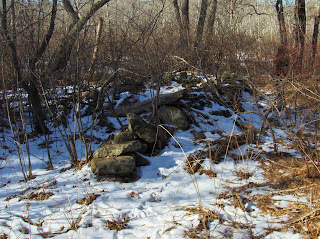Later, the stone wall has an interesting feature:
But the reason we went was to look at the rock piles that look out over a marsh to the west. These are the original "rock piles with hollows and tails" for me, although Norman Muller first used the word "tail" to describe a rock pile. These ones in Carlisle have always been significant to me because they were the first example of any kind of rock piles next to a low marsh and they were the first ones I had seen with hollows that were not up on a hill. And they were the first ones with "tails". Here is the best:
Note the wall of the hollow is well built.
Most importantly, the hollow was not from vandalism.
Here is another, that is pretty far gone:
This pile was not oriented the same as the first one. [Added: In my opinion the shape of a collapse is unmistakeable.]
These structures are at the edge of a marsh and they become indistinguishable from stone wall along the edge of the marsh:
Here is a sketch of some of the pile outlines:
As I wrote previously about this place: there are ditches in the marsh:The mounds are near where the "+" sign is. I wonder about those ditches. It is simplest to assume they were created by the same people who built the stone mounds. I don't think it is a mixture of historic and prehistoric.








No comments :
Post a Comment